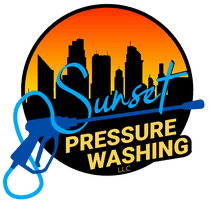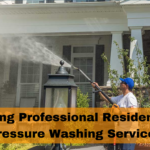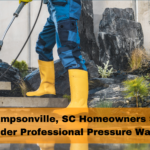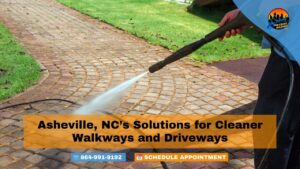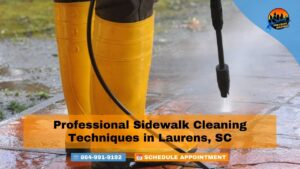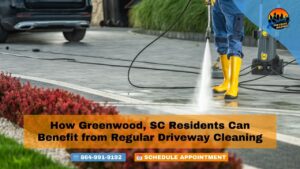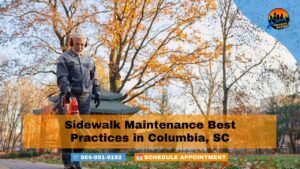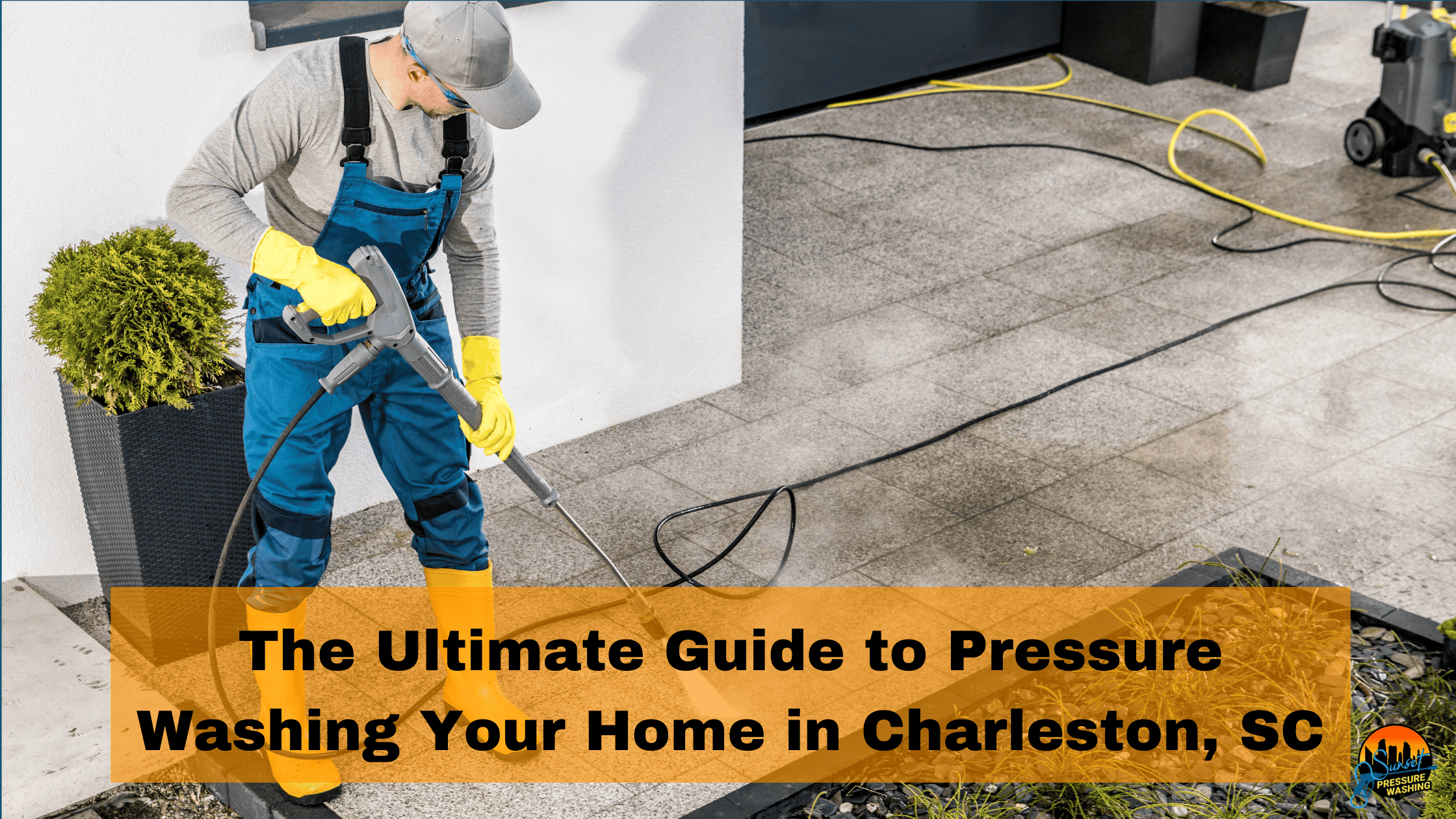
The Ultimate Guide to Pressure Washing Your Home in Charleston, SC
Pressure washing, often also referred to as power washing, is a powerful and efficient way to clean various surfaces around your home. Power washing in Charleston SC is especially important due to the humid climate and proximity to the ocean, as homes can quickly accumulate dirt, mold, and mildew. This guide will walk you through everything you need to know about pressure washing your home, ensuring it looks its best while protecting its integrity.
Why Pressure Washing is Essential in Charleston
Charleston, South Carolina, is known for its beautiful historic homes, charming streets, and coastal climate. While the picturesque environment adds to the city’s appeal, it also brings unique challenges for homeowners, particularly when it comes to maintaining the exterior of their properties. Pressure washing is an essential part of home maintenance in Charleston for several reasons:
Combating Humidity and Moisture
Charleston’s coastal climate is characterized by high humidity and frequent rain, which create ideal conditions for mold, mildew, and algae growth. These organisms can thrive on various surfaces, including siding, roofs, decks, and driveways. Pressure washing effectively removes these contaminants, preventing them from causing further damage.
Preserving Curb Appeal
Charleston’s historic homes and picturesque neighborhoods are a source of pride for residents. Keeping the exterior of your home clean and well-maintained enhances its curb appeal and contributes to the overall beauty of the area. Regular pressure washing removes dirt, grime, and stains, ensuring your home looks its best.
Preventing Structural Damage
Mold, mildew, and algae are not just unsightly; they can also cause significant structural damage over time. Mold and mildew can deteriorate wood, paint, and siding, leading to costly repairs. Pressure washing helps protect your home’s integrity by removing these harmful substances before they can cause damage.
Protecting Health
Mold and mildew are not only detrimental to your home but can also impact your health. These organisms can release spores into the air, which can be inhaled, potentially causing respiratory issues, allergies, and other health problems. Regular pressure washing helps eliminate these health hazards, creating a healthier living environment for you and your family.
Enhancing Longevity of Surfaces
Regular pressure washing can extend the life of your home’s exterior surfaces. By removing dirt, grime, and biological growth, you reduce the wear and tear on your siding, deck, driveway, and other surfaces. This proactive maintenance can save you money in the long run by delaying the need for costly repairs or replacements.
Choosing the Right Equipment
Selecting the right pressure washing equipment is crucial to achieving effective and safe results. The type of equipment you choose will depend on the surfaces you plan to clean and the level of grime and buildup you’re dealing with. Here’s a guide to help you choose the best pressure washing equipment for your needs in Charleston, SC.
Understanding PSI and GPM
Pressure washers are rated by two main metrics: PSI (pounds per square inch) and GPM (gallons per minute).
- PSI: This measures the pressure of the water stream. Higher PSI means more force, which is useful for removing tough stains and grime. For residential use, a pressure washer with 1500-3000 PSI is typically sufficient.
- GPM: This indicates the water flow rate. A higher GPM allows you to clean larger areas more quickly. For most home cleaning tasks, a GPM of 1.4-2.5 is adequate.
Types of Pressure Washers
Pressure washers come in different types, each with its own advantages and ideal uses:
- Electric Pressure Washers: These are generally lighter, quieter, and easier to maintain than gas-powered models. They are suitable for smaller tasks like cleaning patios, decks, and vehicles. Most electric models range from 1300 to 2000 PSI.
- Gas-Powered Pressure Washers: These are more powerful and suitable for larger jobs or heavily soiled surfaces. They offer a higher PSI and GPM, making them ideal for cleaning siding, driveways, and large outdoor areas. Gas models typically range from 2000 to 4000 PSI.
- Hot Water Pressure Washers: These units heat the water before spraying, which can be more effective for removing grease and oil stains. They are usually more expensive and are best for specialized tasks.
Nozzles and Spray Tips
Pressure washers come with various nozzles and spray tips that determine the angle and intensity of the water stream. Here’s a guide to the most common types:
- 0-Degree Nozzle: Produces a narrow, high-pressure jet that is ideal for tough stains but can damage surfaces if not used carefully.
- 15-Degree Nozzle: Provides a narrow spray for heavy-duty cleaning of concrete and hard surfaces.
- 25-Degree Nozzle: Offers a wider spray for general cleaning tasks like washing decks, driveways, and patios.
- 40-Degree Nozzle: Produces a broad spray for delicate surfaces like siding, windows, and vehicles.
- Soap Nozzle: Designed to apply cleaning detergents at low pressure.
Accessories and Attachments
Consider these accessories and attachments to enhance the versatility and effectiveness of your pressure washer:
- Surface Cleaners: These attachments cover a larger area and are great for cleaning flat surfaces like driveways and patios more evenly and quickly.
- Extension Wands: Useful for reaching high places like second-story siding or gutters without needing a ladder.
- Rotating Nozzles (Turbo Nozzles): These nozzles combine the power of a narrow spray with the coverage of a wider spray, ideal for removing tough dirt and grime.
Detergents and Cleaners
Using the right cleaning solution can enhance the effectiveness of your pressure washing:
- All-Purpose Cleaners: Suitable for most general cleaning tasks around the home.
- Deck and Fence Cleaners: Specifically formulated to clean and brighten wood surfaces without damaging them.
- Concrete and Driveway Cleaners: Designed to remove oil, grease, and other tough stains from hard surfaces.
- Eco-Friendly Solutions: Biodegradable and non-toxic cleaners that are safe for plants, pets, and the environment.
Safety Precautions
Pressure washing is an effective way to clean various surfaces around your home, but it can also be dangerous if not done correctly. The high-pressure water stream can cause injuries and damage if not handled properly. Here are some essential safety precautions to follow when pressure washing your home in Charleston, SC:
Wear Protective Gear
Always wear appropriate protective gear to shield yourself from debris and the high-pressure water stream:
- Safety Goggles: Protect your eyes from flying debris and water spray.
- Gloves: Wear sturdy gloves to protect your hands from the force of the water and any sharp objects that may be dislodged.
- Long Sleeves and Pants: Wear long-sleeved shirts and long pants to protect your skin from the high-pressure water.
- Non-Slip Footwear: Wear sturdy, non-slip shoes to prevent falls, especially when working on wet surfaces.
Inspect the Area
Before you start pressure washing, inspect the area for potential hazards:
- Remove Obstacles: Clear the area of any furniture, plants, or other objects that could be damaged or become tripping hazards.
- Check for Loose or Damaged Surfaces: Inspect the surfaces you’ll be cleaning for any loose or damaged materials that could be dislodged by the pressure washer.
- Cover Electrical Outlets: Use plastic sheeting or painter’s tape to cover and protect any outdoor electrical outlets, light fixtures, or other electrical components.
Use the Right Nozzle
Using the correct nozzle for the task is crucial to avoid damaging surfaces or causing injuries:
- Choose the Right Spray Pattern: Select the appropriate nozzle for the surface you’re cleaning. Wider spray patterns (25-degree and 40-degree nozzles) are safer for delicate surfaces, while narrower patterns (0-degree and 15-degree nozzles) should be used cautiously and for tougher cleaning tasks.
- Test the Nozzle: Test the nozzle on a small, inconspicuous area to ensure it won’t damage the surface.
Maintain a Safe Distance
Keep a safe distance between the nozzle and the surface you’re cleaning to avoid damage and injury:
- Distance from Surface: Hold the nozzle at least 6-12 inches away from the surface. Adjust the distance based on the surface and the cleaning task.
- Distance from People and Pets: Keep people and pets away from the area being cleaned. Never point the pressure washer at yourself or others.
Avoid Using Ladders
Using a pressure washer while on a ladder can be extremely dangerous due to the force of the water stream and the potential for losing balance:
- Extension Wands: Use extension wands to reach high areas without needing a ladder.
- Stabilize Yourself: If you must use a ladder, ensure it is stable and secure. Have someone hold the ladder for additional support.
Be Cautious with Detergents
When using detergents and cleaning solutions, follow these safety guidelines:
- Read Labels: Read and follow the manufacturer’s instructions and safety warnings on the detergent label.
- Use Biodegradable Cleaners: Choose biodegradable and non-toxic cleaners to minimize environmental impact.
- Avoid Inhalation and Skin Contact: Wear gloves and a mask when handling detergents to avoid skin contact and inhalation of fumes.
Preparing Your Home
Proper preparation is key to a successful pressure washing experience. Before you start blasting away dirt and grime, taking a few essential steps can ensure that you clean effectively while protecting your home and its surroundings. Here’s a comprehensive guide to preparing your home for pressure washing in Charleston, SC.
Clear the Area
Remove any obstacles from the area you plan to pressure wash:
- Outdoor Furniture and Decorations: Move patio furniture, grills, potted plants, and decorations to a safe location.
- Vehicles: Park cars and other vehicles away from the area to avoid potential damage from overspray.
- Children and Pets: Keep children and pets inside or away from the work area to ensure their safety.
Protect Sensitive Areas
Shield areas that could be damaged by high-pressure water or cleaning solutions:
- Electrical Outlets and Fixtures: Cover outdoor electrical outlets, light fixtures, and doorbells with plastic sheeting or painter’s tape to prevent water from entering.
- Delicate Plants and Shrubs: Protect plants and shrubs by covering them with tarps or plastic sheeting. This prevents damage from strong water jets and cleaning chemicals.
- Windows and Doors: Close all windows and doors tightly to prevent water from seeping inside your home.
Inspect the Surfaces
Check the surfaces you plan to clean for any damage or areas that might require special attention:
- Loose Siding and Trim: Inspect your siding and trim for loose or damaged sections. Secure or repair these areas to prevent further damage during pressure washing.
- Cracks and Gaps: Seal any cracks or gaps in walls, foundations, and sidewalks to prevent water from entering and causing further damage.
- Mold and Mildew: Identify areas with heavy mold or mildew growth. These spots might need extra attention and pre-treatment.
Pre-Treat Stubborn Stains
Some stains may require pre-treatment before pressure washing:
- Cleaning Solutions: Apply a suitable cleaning solution to stubborn stains, mold, and mildew. Let it sit for a few minutes to loosen the dirt and grime.
- Scrubbing: For particularly tough spots, use a scrub brush to agitate the cleaning solution into the stain before rinsing.
Choose the Right Cleaning Solution
Selecting the appropriate cleaning solution is crucial for effective and safe pressure washing:
- All-Purpose Cleaners: Use for general dirt and grime on most surfaces.
- Deck Cleaners: Specially formulated for wood surfaces, helping to remove mildew and restore natural color.
- Concrete Cleaners: Designed to tackle oil stains and heavy grime on driveways and sidewalks.
- Eco-Friendly Solutions: Opt for biodegradable and non-toxic cleaners to minimize environmental impact.
Step-by-Step Pressure Washing Guide
Pressure washing can be an incredibly effective way to clean your home’s exterior, but it requires careful execution to achieve the best results and avoid damage. Here’s a detailed step-by-step guide to pressure washing your home in Charleston, SC.
Gather Your Equipment
Ensure you have all the necessary equipment and supplies ready:
- Pressure Washer: Electric or gas-powered, with appropriate PSI and GPM.
- Nozzles: A variety of spray tips (0-degree, 15-degree, 25-degree, 40-degree, and soap nozzle).
- Cleaning Solutions: Appropriate detergents for different surfaces.
- Protective Gear: Safety goggles, gloves, long sleeves, and non-slip shoes.
- Extension Wands: For reaching high areas without a ladder.
- Tarps and Plastic Sheeting: To cover and protect sensitive areas.
- Scrub Brushes: For pre-treating stubborn stains.
Set Up the Pressure Washer
Prepare your pressure washer before starting the cleaning process:
- Check Oil and Fuel Levels: For gas-powered models, ensure the oil and fuel levels are adequate.
- Connect Water Supply: Attach your pressure washer to a water source, such as a garden hose, and ensure the connection is secure.
- Attach Nozzle: Choose the appropriate nozzle for the task and attach it to the pressure washer wand.
Pre-Treat Stains and Mildew
For areas with heavy stains, mold, or mildew, pre-treating can make the cleaning process more effective:
- Apply Cleaning Solution: Spray the cleaning solution on the affected areas and let it sit for a few minutes.
- Scrub Stubborn Areas: Use a scrub brush to agitate the solution into the stains before rinsing.
Test the Pressure Washer
Before starting on large areas, test the pressure washer on a small, inconspicuous spot:
- Small Test Area: Test to ensure the pressure and nozzle choice won’t damage the surface.
- Adjust Settings: Adjust the pressure and nozzle settings based on the test results.
Start from the Top
When pressure washing, always work from the top of the house down to prevent dirty water from dripping onto clean areas:
- Begin at the Roofline: Start at the roofline and work your way down to the foundation.
- Move Side to Side: Use smooth, overlapping strokes to ensure even cleaning and avoid streaks
Maintain a Safe Distance
Keep the nozzle at a safe distance from the surface to avoid damage:
- Optimal Distance: Maintain a distance of at least 6-12 inches from the surface. Adjust based on the material and dirt level.
- Consistent Motion: Keep the nozzle moving to avoid concentrating the pressure on one spot for too long.
Clean Different Surfaces Appropriately
Different surfaces require different techniques and nozzles:
- Siding: Use a 25-degree or 40-degree nozzle for vinyl, wood, or stucco siding. Keep the nozzle at a wider angle and a safe distance to prevent damage.
- Decks and Patios: Use a 15-degree or 25-degree nozzle. For wood surfaces, use a wider spray pattern to avoid gouging the wood.
- Driveways and Walkways: Use a 15-degree nozzle or a rotating turbo nozzle for tough stains. Move slowly and steadily to ensure thorough cleaning.
Cleaning Different Surfaces
Pressure washing different surfaces around your home requires specific techniques and equipment to ensure effective cleaning without causing damage. Here’s a detailed guide to cleaning various surfaces, including siding, decks, patios, driveways, and walkways, to keep your Charleston, SC home looking pristine.
Siding
Cleaning your home’s siding, whether it’s vinyl, wood, or stucco, requires care to avoid damaging the material:
- Vinyl Siding: Use a 25-degree or 40-degree nozzle for a wider spray pattern, which reduces the risk of damage. Hold the nozzle at a 45-degree angle to the siding and maintain a distance of 6-12 inches. Start from the bottom and work your way up to avoid streaking, then rinse from the top down.
- Wood Siding: Choose a lower pressure setting and a wider spray pattern (40-degree nozzle). Keep the nozzle at least 12 inches away from the surface to prevent gouging. Be sure to clean with the grain of the wood to avoid damaging the siding.
- Stucco: Use a 25-degree nozzle and a medium pressure setting. Hold the nozzle 18-24 inches away from the surface and use even, sweeping motions. Pay extra attention to cracks and crevices where dirt and mold can accumulate.
Decks and Patios
Decks and patios often require special attention to remove built-up dirt, algae, and mildew:
- Wood Decks: Use a 25-degree nozzle to prevent damaging the wood fibers. Start with a lower pressure setting and increase as needed. Hold the nozzle 12-18 inches away from the surface and move with the grain of the wood. Avoid staying in one spot for too long to prevent gouging.
- Composite Decks: Use a 40-degree nozzle and a low-pressure setting to avoid damaging the composite material. Keep the nozzle at least 12 inches away and use gentle, sweeping motions.
- Patios (Concrete/Stone): For concrete or stone patios, use a 15-degree or 25-degree nozzle. Higher pressure settings can be used for tougher stains, but maintain a safe distance to avoid etching the surface. Move in consistent, overlapping strokes for even cleaning.
Driveways and Walkways
Driveways and walkways often accumulate oil stains, grime, and algae, requiring a more powerful approach:
- Concrete Driveways: Use a 15-degree nozzle or a rotating turbo nozzle for maximum cleaning power. Hold the nozzle 12-18 inches away from the surface and use slow, even strokes. For stubborn stains, apply a concrete cleaner, let it sit for a few minutes, and then rinse thoroughly.
- Brick Walkways: Use a 25-degree nozzle and medium pressure. Keep the nozzle at least 12 inches away to avoid dislodging the mortar between bricks. Move in a back-and-forth motion and rinse thoroughly to remove any residual cleaner.
- Paver Walkways: Use a 25-degree nozzle and a medium pressure setting. Maintain a distance of 12 inches from the surface and clean in overlapping strokes. Be cautious around joints to avoid displacing the sand or gravel.
Roofs
Cleaning your roof requires a gentle approach to avoid damaging shingles or tiles:
- Asphalt Shingles: Use a low-pressure setting and a 40-degree nozzle to prevent lifting or damaging the shingles. Apply a roof cleaner specifically designed for asphalt shingles, let it sit for the recommended time, and then rinse gently.
- Tile Roofs: Use a 25-degree nozzle and low to medium pressure. Keep the nozzle at least 24 inches away from the surface to avoid cracking the tiles. Clean in small sections to ensure even coverage and thorough rinsing.
Outdoor Furniture
Outdoor furniture can also benefit from pressure washing:
- Plastic Furniture: Use a 40-degree nozzle and low pressure. Keep the nozzle 12 inches away and use even, sweeping motions.
- Metal Furniture: Use a 25-degree nozzle and medium pressure. Maintain a distance of 12 inches and avoid focusing on any one spot for too long to prevent paint from chipping.
- Wood Furniture: Use a 40-degree nozzle and low pressure. Keep the nozzle 12-18 inches away and move with the grain of the wood. Avoid high pressure to prevent splintering.
Keep Your Charleston Home Pristine with Regular Pressure Washing
Pressure washing services in Charleston SC, are essential for maintaining the beauty and integrity of your home. The humid climate and coastal environment can quickly lead to the buildup of dirt, mold, and mildew, which can cause long-term damage and detract from your home’s appearance. By following the steps outlined in this ultimate guide, you can ensure your home remains clean, safe, and visually appealing.
Take action today! Whether you decide to tackle the job yourself or hire a professional service, keeping up with pressure washing such as residential pressure washing in Charleston SC will enhance your home’s curb appeal, extend the life of your exterior surfaces, and protect your family’s health. Don’t wait until dirt and grime take over—make pressure washing a regular part of your home maintenance routine and enjoy a cleaner, healthier living environment year-round. Book now and learn more about our services!
